Industry Super Australia has published findings from a report commissioned by the NSW Community Housing Industry Council, which proposes solutions for the “shortfall” in community and social housing.
The Fixing Affordable Housing in NSW and Beyond report – authored by Industry Super Australia chief economist Stephen Anthony – found that shortages of social and affordable housing “continue to widen”.
According to the report, the social and affordable rental housing gap in NSW is estimated to increase by an additional 100,200 units by 2036.
Mr Anthony attributed the shortfall to a misallocation of state and federal government resources.
“Against the measured shortages of social and affordable housing, you would think that Australian governments must not be spending enough on assistance,” he said.
“This impression is false. Commonwealth and state governments already spend at least $7 billion annually on housing in NSW.
“The problem is that most dollars are targeted at mum and dad investors rather than the disadvantaged.”
He added: “The remaining dollars are spent on a ‘mishmash’ of disparate programs spread across layers of governments with no overarching coordination.”
The chief economist said existing approaches to housing subsidies – including negative gearing arrangements, capital gains tax concessions, and monetary and prudential policy settings – have contributed to the supply and demand imbalance in the affordable housing space.
“Federal tax incentives fuel investor demand for existing property. One could be forgiven for thinking the goal of Australian government housing subsidies to give high wealth, mum-and-dad investors the ability to buy multiple existing properties using debt via a do-it-yourself super fund,” Mr Anthony continued.
“Monetary and prudential policy has also fuelled a debt-driven growth model for three decades.
“Easy money and prudential policies have driven a housing-finance feedback cycle that is economically inefficient, incentivising investment in unproductive activity but strongly self-perpetuating in terms of its dynamics.”
Mr Anthony called on governments to “reprioritise” their spending in a bid to “arrest the slide” in adorable housing supply.
“It is estimated that the cost of building enough social and affordable housing in NSW to meet the shortfall – 316,700 units by 2036 – would be about $3.5 billion annually, which is only around half of the current outlays on housing,” he said.
“So, the key to addressing the social and affordable housing shortfall is to achieve a more appropriate re-prioritisation of the existing spending envelope.”
The chief economist encouraged policy makers to incentivise investment in social and affordable housing development.
“Subsidies must be better targeted towards greenfield developments undertaken mainly by large-scale not-for-profit entities such as some Community Housing Providers (CHPs),” Mr Anthony stated.
“The idea is to attract enough equity investment into the sector in scale so that CHPs can leverage their balance sheets to solve the problem for Australian governments.”
Accordingly, Mr Anthony proposed the introduction of an “Affordable Housing Tax Credit”, which would enable equity investors to purchase tradeable tax credits in exchange for equity funding directed to regulated CHPs.
The economist also called for the establishment of a “Financial Corporation Investment Fund” – an independent body established by government that could invest in affordable housing developments based on a rate-of-return benchmark.
Other proposals include:
- the establishment of an oversight agency to “identify shortages to guide better local planning”;
- tax reforms, which may include replacing stamp duties with a land tax; and
- the coordination of macropolicy to support the goal of “normalising unimproved land values over time”.
NSW Premier Gladys Berejiklian and Victorian Premier Daniel Andrews recently confirmed that stamp duty reform would be considered as part of an economic agenda designed to rejuvenate the economy in the wake of the COVID-19 crisis.
Industry Super Australia’s report also follows the announcement of a new agreement between the Commonwealth and NSW governments to fund 781 new social and affordable homes through the National Housing Infrastructure Facility.
The agreement forms part of the federal government’s “Reducing Pressure on Housing Affordability” program, announced in the 2017-18 budget, which aims to finance infrastructure projects to boost the supply of community housing.
[Related: NHFIC to fund $100m in affordable housing projects]
 ;
;
